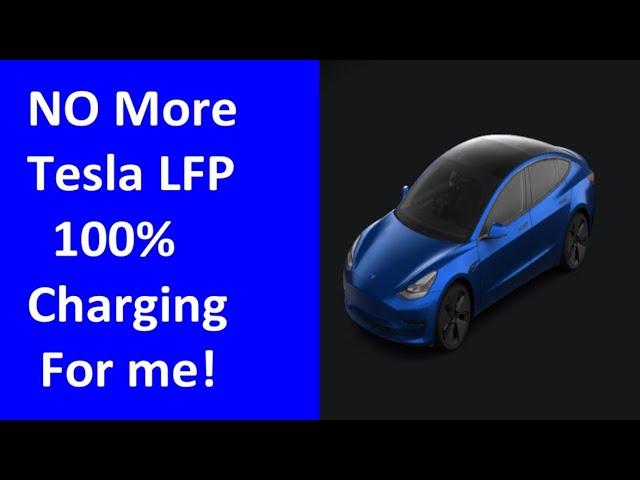
No more 100% LFP Charging for me! @Tesla Travel
Комментарии:

Hi thanks for watching my video & since making it a year ago I’ve made updates which I say I now charge to 100% at home and superchargers enough to get me to my destination or next charger.
Thanks for watching & take care

I have a 2023 Mach-e with LFP batteries and have been charging to 80%. Ford says to charge LFP batteries to 100% at least once a month. Tesla says every week. I am splitting the difference and charging to 100% once every two weeks. I only drive about 7500 miles/yr total. Thanks for doing the video. How are you charging your vehicle now since doing the video a year ago?
Ответить
I don't have a Tesla Model 3 though I would love to have one. I have a Chevy Spark EV that does have an LFP battery. I think this video is spot on. I only charge to 100% once a week which is to keep the range estimator accurate. When I get home I immediately charge to 70% or just under. Since I don't drive everyday this is the ideal percetage of charge to leave the EV sitting at. Then when I know I am going someplace I charge my EV more if I am going to need more range than 70% affords me. Or course if the EV sits or a week or two at 70% no real big deal. I do my best to not let my battery get below 20%. I know EV manufactures add a buffer range to both top and bottom so 20% indicated isn't the real 20% nor is 100% the real 100%. Staying between 20% and 70% indicated will just insure I am in the safe zone and if I go a bit below or above isn't going to do any damage either.
Ответить
I have been using lithium iron phosphate batteries for a long time with solar, and the 3 things that damage them are: charging too fast and charging all the way to 100%. Never had to worry about the wheather.
Ответить
great video. however : you can't calculate the life of the car all the way to 0% of battery health. Long before you reach zero, the car will have no use. At some point the car will barely be good enough to get to the shopping centre and back.
Ответить
That 100% LFP Charging fallacy from TESLA was because these batteries do not offer the same energy storage capacity/range as the ternary chemistries and as a marketing ploy to make customers buy these LFP vehicles, Mr Musk said you can safely charge to 100% with minimal degradation! Tesla is exploiting the fact that LFP can endure more charge-discharge cycles, but battery longevity is still based on how much, you top charge and much deep you discharge.
Ответить
Your initial rapid loss is likely not due to keeping it at 100% SOC, but rather, because LFP has an aggressive degradation curve in the first year, and then flattens out.
As far as Tesla battery life- I think it's overhyped. My 5 year old Model 3 (NMC) charges to 80% per Tesla advice, and it has 11% degradation in 66,000 miles. I believe this is due to repeated supercharging while towing (1/3 of my charges are supercharging).

You will do more damage by no longer charging to 100% since the battery will no longer be able to balance. Also, you can't calculate degradation based on the range indicated since that is calculated partially by your driving habits. Also, the first year or so will show the most degradation and it slows after that. Yes, all batteries will degrade, but the LFP will do so less. You might try what I do with my LFP M3. I typically charge from 30% to 70% because my daily doesn't require too much range. But, about once a week or as much as once every 10 days, I will drive it to below 10% and leave it there a few hours, then slow charge to 100%. I'll do it overnight regulating the rate on the app to arrive at 100% just before I drive. At most, it stays at 100% for 1/2 hour to an hour or so. After 11 months, my degradation is about 2.5%. Remember, balancing your battery must be done after it's down below 10% up to 100%. There are times that after this, you'll see higher range predictions because of the balancing. I know my comment is a year late, but some may find it useful. Also, my previous non-LFP Tesla almost never went over 80%. Only on road trips, otherwise almost never.
Ответить
Well there should be a law that every ev be like mine. My Car has a 10% degradation buffer that means my car has 110% Brutto capacity. The car uses the 10% to balance out the degradation. Before 150k Km you dosent even need to think about it in most cases these cars are still over 100% and didnt used there full buffer. its not lfp but still awesome they did it that way.
Ответить
i would like to see the degradation result after you stop charging to 100% of the next 7k mi
Ответить
LFP degradation curve is steeper than l-ion initially but tails off at around 8-10% and will stay relatively flat for far more cycles than l-ion
Ответить
My wife and I bought an LFP Tesla this past summer and now have about 8000 miles on it. It started with 273 miles of range and now we have 268-269. HOWEVER, I have noticed that now that the range has gone down, the car's "guess-o-meter" will stay at 269 miles for about three or four miles down the road until it starts counting down! My contention:
Some of this is degradation, some of it is the algorithm adjusting for our predominantly highway driving, and some of it is inaccuracy and we actually get more miles than it predicts!
I'm not too worried about charging to 100%, which we do about twice per week. However, I will NEVER charge to 100% unless I know that we are going to be driving it the next morning so it will never sit at 100% for more than a couple of hours. Thanks for the video, sir!

My M3 RWD mfr Sept/2023 Fremont CA workshop has 1% LFP batt degradation as per Tessie app. I charged 5 times to 100% total 237 kwh at only superchargers during last 1 month of ownership and driven 740 miles. Not sure if this is unusual.
Ответить
I have a 2022 LFP Model Y. I also understood that the 'charge to 100%' guidance was more for accurate range prediction than it was for battery maintenance and LFP still would rather be charged to less than 100% if possible. But as a single charge largely lasts me a whole week anyway, I just charge it to 100% once a week or before road trips and don't worry about it too much. I always have the screen range set to a percentage and not a mileage too.
Ответить
Interesting... it never made sense to me, anyway, to charge to 100% with the LFP pack, not only because it's bound to impact on battery health in some way, but also because it reduces overhead charging capacity, for the purposes of allowing regen braking, until the soc drops sufficiently. Currently on a later Shanghai M3LR, I've not ever charged above 90% in 20k mls, and generally hold charge between 40-75%, unless planning a particularly long round trip.
Ответить
Lfp has a very flat voltage discharge curve which will make the status of charge quite hard to determine from that and make it totally reliant on the accuracy of its current meters.
I also would not assume you have lost that much range as the gom uses al sorts of variables to estimate your range.

Yeah I used to used LFP batteries in my home built motorcycle about 7 years ago, used to need to charge fully to balance out the cells. Moved to better technology, was a massive improvement.
Ответить
I have over 3500 miles on my new 2023 Tesla 3 and keep my car at 100% most of the time on the home charger. It is the same as the first time I charged it 3 months ago….270 miles. I’ve lost nothing so far!
Ответить
Not likely that the degradation would continue at the same pace. However, if it would then you actually would not have practical 350k miles useable life, but you would already be at 70% useable at around 100k miles. And thereafter not very useable in practice.
Ответить
The mistake here was to assume the LFD degradation was going to be linear. It is not. Tesla's advice is aimed at maintain the battery life so that they do not have to replace it under warranty. There is a relatively rapid loss at first which then slows down. It's best not to regard the initial capacity (= range) as the actual capability/range of the vehicle - in effect it has 'over capacity' to start with. This is yet another example of how different battery technologies differs from fuel tank technology! Apparently this behaviour is inherent in the way the chemistry of a LFP battery works. Don't forget that LFP can be charged to 100% and left at that charge level without any undue degradation - you should not do that with the higher energy density NMC types used in longer range vehicles. You can charge those t 100% but should then use the charge fairly quickly to avoid degradation. LFP is a safer but less energy dense technology, even less likely to burst into flames as it does not suffer from thermal runaway if the battery management system fails and is reportedly somewhat more environmentally and socially acceptable in manufacturer and eventual disposal.
Ответить
My model Y has a Lithium-ion low voltage battery type! How should i charge my car?
Ответить
It seems like there are two issues: how often you charge to 100%, and how long the car sits at that level. Another unanswered question is, what happens when the BMS incorrectly indicates zero range remaining? I just got a Standard Model 3, LFP battery. My plan is to charge to 100% only just before I am able to use the car to lower the level to at least 90%. When charging to a lower limit, I plan to pay attention to the number of miles driven since the last charge, in addition to looking at the less-than-accurate battery level indicator.
Ответить
I have a 2023 M3RWD. I don't need 100% daily. I charge to 100% on Sunday nights. Set it to 80% the next 2 nights. Then on Wednesday nights I set it back to 100%. Then 80% until Sunday. That way, at least twice a week, my BMS is calibrated. I know LFPs can tolerate 100% better but it's still a Lithium battery. I think Tesla doesn't want to confuse people so they just say set it to 100% and be done with it.
I'd say most people won't keep a car long enough to see any serious degradation and Tesla knows that.

This is why you don't go by the mileage and use battery percentage.
I have the 55Kwh SR+ with LFP and it started 273 miles when new. 18000 later it states 251 miles. However I can still pull 51Kwh from it 100 to 0% after losses which is pretty good. (Baring in mind it has around 52.5Kwh usable) I think the mileage was just a bit unrealistic and now is just more accurate.
Also point to note that if your battery is cold you'll see less range. You can see a blue portion on your charging selection bar on the app showing this.
So don't worry about it

Great knowledge, Thanks for sharing.
Ответить
I don’t think it is degradation as much as it is learning the real range based on how you drive. Also we charge ours at 12 amps 99% of the time. According to Recurrent we still have a 269 mile range with just over 6,000 miles on the odometer.
Ответить
I love all of the comments saying people are going to stop following Tesla the expert in batteries and start charging to 80%. If Tesla says charge to 100% daily when possible and 100% weekly then you should do it. What happens when you try to put in a battery warranty claim and you haven’t followed what Tesla says they may deny your claim as you did not care for the battery correctly.
Ответить
It would be useful for someone to come up with a reliable way to estimate range on the LFP battery when only charged to 80%.
Ответить
I think it is wise to consider leasing a Tesla and the not worry about battery life at all, I do this paying $350 per month and will then get a new car with the latest technology when the lease expires.
Ответить
There is some truth and misleading info in what is said in the video. The degradation of the battery isn’t given by the range you see at full charge. That’s a number based on an algorithm used by the BMS, based on the lowest and highest voltage of the cells readings (and some other stuff) of a LFP battery. The LFP battery has very low difference in voltage between max and min values. This is why the car needs to be charged to 100%, so that the cells are balanced and the BMS is capable to read the max value. If people drive their LFP cars only a small amount of capacity every day (from 80% to 60% SOC) the BMS will fuckup and no longer will be able to read the Min and Max values correctly. If someone wants to know the capacity loses, he has to charge to 100% and drive the car in one run to 3-5% and note the kWh used. And compare this number with the battery capacity they had in the day one they got the car. It’s important to have this reference number though. This is how the capacity loses are measured, not using a number on the screen given by a BMS algorithm.
Ответить
Problem is, LFP degrades 3x slower. So i don't care anymore. I charge when i need to charge. And try to use 11kW chargers.
Ответить
Finally a video talking about LFP batteries that brings up some valid points! I recently purchased a 2020 TM3 with the LFP battery.. I have been trying to find out the best methods of charging to ensure I keep the battery very healthy. I think I will charge to 80-90 daily and to 100% every 7-14 days. I subbed and I hope I can find more info on charging habits, surge times and learning when to charge to save money. This is my first EV and I still don't know everything just yet.
Ответить
I charge my LFP 10 100% every single night...but I don't supercharge at all and actually only charge with the mobile connector. So a nice and slow charge rate.
Ответить
Charging an LFP to 100% is similar to charging a regular li-ion battery to 80-90% so charging to 100% regularly is not an issue. Also degradation curve is steeper at first and levels off so your assumption of 1% = 20,000 miles is not true. They will degrade 1% in month not even doing any miles through initial age based degradation. With an LFP, drive it, charge it, a few times a week charge it to 100% to make sure BMS is calibrated and stop worrying about it.
Ответить
Thank you sir. I just got my Tesla a week ago. Most places said don’t charge up to 100% but my Tesla app said charge it to 100%.
I will probably keep it at 80% till I need to take a long road trip.

Don’t use super chargers to go to 100% using the mobile connector will not decease range so quickly when going to 100% bur fast changing will.
Ответить
If Tesla says 100% then it's 100% for me. There will always be someone who thinks they're smarter than Tesla.
Ответить
The reason EV manufacturers are requesting 100 % charging periodically is to trigger cell balancing..!! The reason EV fires happens is due to one or more cells being at varying SOC,,,,, thus,,,, when charging the voltage increases dramatically and dangerously high on a few individual cells..!! This causes cells to swell, vent, and eventually catch fire if they are Lithium Ions..!! LFP batteries are much safer and generally will only vent instead of catching fire..!! Owners of EV's need to fully understand the battery chemistry being used and also understand how the Battery Management Systems (BMS) operate..!! Besides the BMS programming, the individual cell voltages, logging, and battery balance programming routines should be completely available to the vehicle owner..!! If you're NOT able to access this information and understand it you are risking personal property damage or potentially life threatening situations without even knowing it..!! Being safe with EV's is all about individual cell voltage monitoring throughout the entire charge/discharge cycle..!! This information needs to be available to you as you drive,,,, NOT a pretty green picture of a battery showing how many miles you can drive..!!
Ответить
Thanks for the Video very interesting. Did you try to balance the Cell Voltage? (Charge to 100%, drive till under 10% and than charge to 100% again till the car stops charging, balancing can take another hour or more after it shows 100%). Keep in mind that it is much harder to measure the right percentage for the BMS of a Lfp Battery because the CellVoltage difference between full and empty is much lower, so if you now only charge it to 80% after a while it could mean that this 80% showing isn't 80, maybe only 70 or 60%. Can you post the link of the Article? I couldn't find it.
Ответить
I have been noticing the range drop on my m3RW which I took delivery in 10/31. It is about 3 miles dropped on full 100% charged. I only charged it to 100% for about 4 times only. I don’t use the car often and the daily drive is about 15 miles in average (some days will drive more than others but in average- 15 miles per day).
I am very puzzled about the range drop and it is very weird.
Also, I have about 2000 miles on the car. I think it was about 1400 miles when I noticed the drop.
I have started charging to the car using lower amp.
Is it a BMS not being balanced? Or is it a true battery degradation at so early stage?

Just got a tesla (lfp) and lost a mile after 1k of driving. And I charge to 100% every chance I get. It's not a lot of loss (yet) but it got me a bit concerned until I realized that at the end of the day you have to look at the ev more like a phone than a gas car. The software is basically guestimating how much the mileage is based on a number of factors. But at the end of the day, it's not absolute and fixed. For gas cars the mileage-to-gas correlation is more in tune because there's less factors that effect the efficiency of gasoline (its pretty consistent). But with battery, you can literally waste power but leaving the car parked with sentry mode on and therefore get less mileage. Real battery degradation, I would guess, is when you can't charge to 100%. If your tesla's full charge drops to 99 or 98% I would then be a lot more concerned about degradation. I'm new to this so feel free to correct me if I'm understanding it incorrectly.
Ответить
I think your calculation is incorrect. Degradation is NOT linear. You might lose 3% in the first 20,000 and then lose 5% over the next 100,000. The car is also adjusting range based on your roads, climate etc. It’s in teslas best interest to simplify the charging process and make them last as long as possible. It’s highly possible that 100% displayed is not physically 100% SOC. Same goes for 0%.
If it WAS 100% SOC you would not be able to regen brake straight out of your driveway….
If it was 0% why do teslas continue to drive for 40miles!!!! The software is doing this for you! Have faith in the BMS!!!!
Not one individual on this earth has better data collection on the health and management of large battery packs then Tesla. I think your way over complicating things.
Having worked on batteries my whole life, I Personally I do what the manufacturer recommends, no blog article is going to have the motivation or knowledge above and beyond teslas own recommendations.
The SINGLE biggest questions people have about teslas is battery degradation and range. I suspect Tesla want the best for your car…. If 95% SOC prevented 80% of the degradation, wouldn’t they say charge to 95%… I suspect the software is doing that for you….

This isn’t new to Tesla LFP run a lower voltage and are stable at 100%. Think of voltage like pressure. A full water balloon ready to pop is unstable. Now fill it up half way… you could throw it at the wall and it won’t pop. Voltage is like pressure and LFP runs a lower voltage.
Ответить
Do you expect to keep your car past 8 years? I’m sure I’ll have traded mine long before 8 years.
Ответить
Thanks for the video. I’m looking for good info on the Lfp battery. But what you are measuring isn’t necessarily “degradation” especially in the beginning. We really don’t know what Tesla does with the battery management so it’s hard to say what’s happening. There’s an interesting article I read about how the computer needs calibration readings but can only do that with enough “sleep” time to get enough data. Until then it will estimate on the low side because charging more makes people less and than calling a flat bed truck. The LFP battery seems to be even more hard to get good readings for calibration than the NCA. When you hit 100% overnight for example the car will sleep and also the computer will get good data as to the condition of the cells. If I understand correctly this is why Tesla want at least one 100% reading per week.
As for your calculation, afaik battery degradation isn’t linear you can’t just say I’ve lost 2% in XXX miles so therefore it will be zero in 50*XXX miles. There are other things like discharge/charge rate that will effect the l”usable life” of the battery other than capacity.

This is one of the few videos I have seen really discussing this issue with the LFP batteries. People are talking about the degradation, but they are not talking about reducing the charge to help address it. I would love to know what happens if you only decide to charge it to 80 or 90% daily. Is it going to lose more capacity? Will the BMS get confused? I would love to know what happens. I am more inclined to not fully charge just because that is what I have always done. The LFP option looks interesting, but I am concerned about this charging question. Please post a follow up on how this works out and what you are seeing since changing the charging. Any issues?
Ответить

























